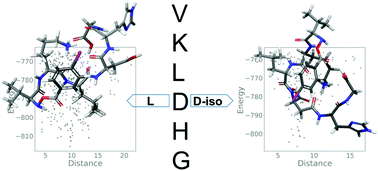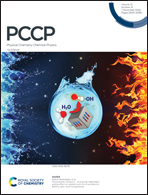Differentiation of peptide isomers by excited-state photodissociation and ion–molecule interactions†
Abstract
Solvochromatic effects are most frequently associated with solution-phase phenomena. However, in the gas phase, the absence of solvent leads to intramolecular solvation that can be driven by strong forces including hydrogen bonds and ion–dipole interactions. Here we examine whether isomerization of a single residue in a peptide results in structural changes sufficient to shift the absorption of light by an appended chromophore. By carrying out the experiments inside a mass spectrometer, we can easily monitor photodissociation yield as a readout for chromophore excitation. A series of peptides of different lengths, charge states, and position and identity of the isomerized residue were examined by excitation with both 266 and 213 nm light. The results reveal that differences in intramolecular solvation do lead to solvochromatic shifts in many cases. In addition, the primary product following photoexcitation is a radical. Ion–molecule reactions with this radical and adventitious oxygen were monitored and also found to vary as a function of isomeric state. In this case, differences in intramolecular solvation alter the availability of the reactive radical. Overall, the results reveal that small changes in a single amino acid can influence the overall structural ensemble sufficient to alter the efficiency of multiple gas-phase reactions.

- This article is part of the themed collection: PCCP Editor’s Choice, 2020


 Please wait while we load your content...
Please wait while we load your content...
